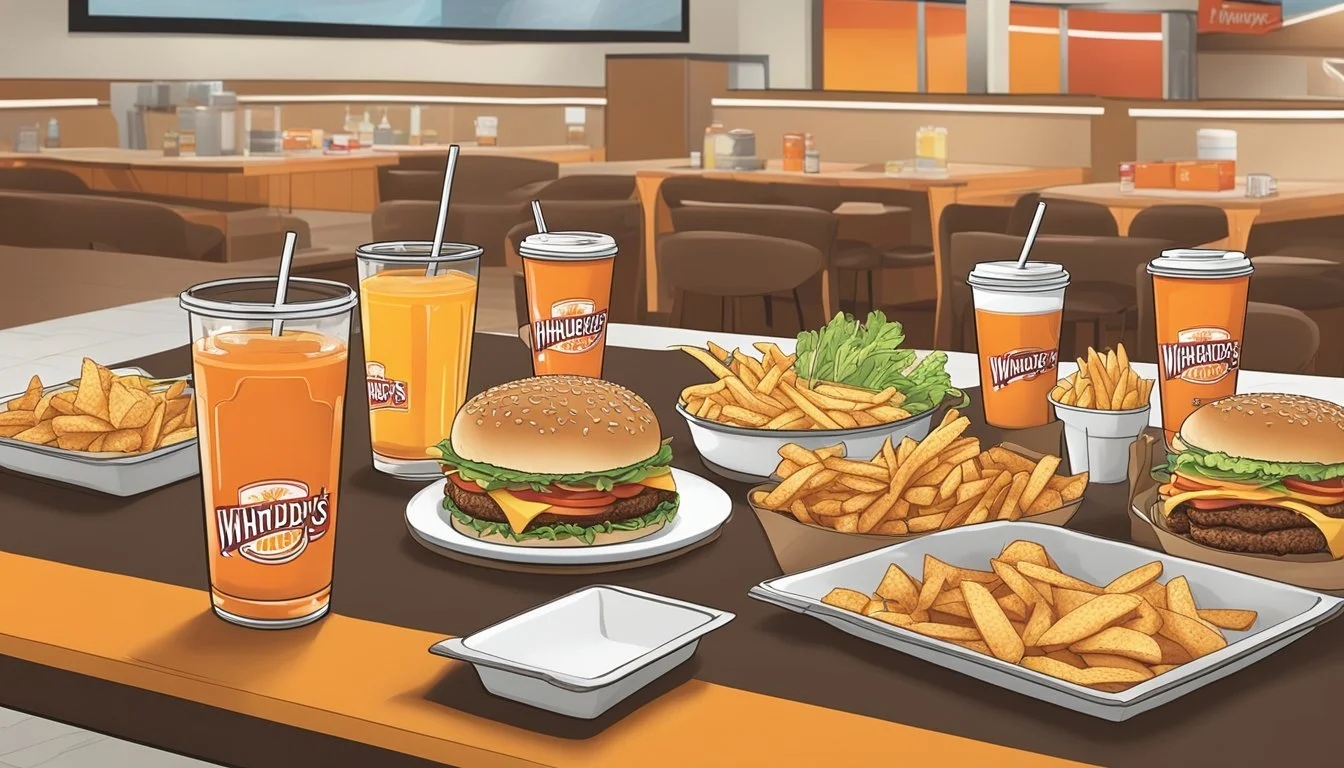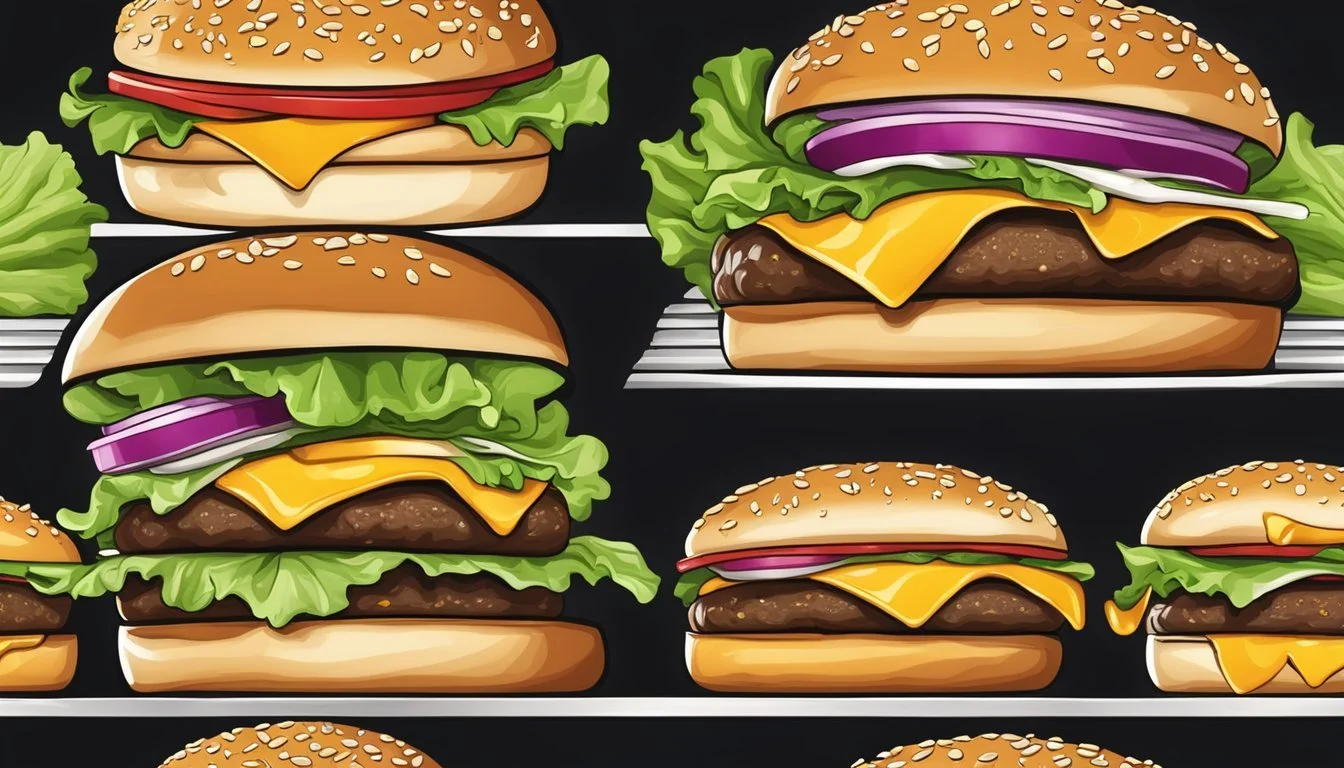Wendy's vs Whataburger
A Comparative Analysis of Burger Quality and Value
In the world of fast-food chains, burger enthusiasts often find themselves debating the merits of their favorite spots. Wendy's and Whataburger are two heavyweights in this arena, with both brands boasting a fervent fan base. Wendy's, known for its square beef patties and offerings of fresh, never frozen beef, stakes its claim with a menu that includes a variety of burger options, chili, and its famous frosty. On the other hand, Whataburger, a regional favorite particularly in the Southwest, tempts with its larger, customizable burgers and distinct A-frame orange and white striped restaurants.
The decision on which is better can be subjective and often comes down to personal preference in taste, menu variety, and the overall dining experience. Customers might weigh the freshness of ingredients, the convenience of locations, and the consistency in quality when making their choice. While Wendy's has a broader national presence, Whataburger enjoys a loyal following in the states it serves, offering a range of exclusive items that cater to a more localized palate.
Comparing Wendy's and Whataburger side-by-side encompasses various factors such as nutritional content, price, customer service, and brand loyalty. Recent discussions and comparisons have brought to light considerations ranging from healthy options and ingredient transparency to the economic value of the meals offered. These aspects contribute significantly to the ongoing debate over which burger joint stands out as the superior choice for fast-food aficionados.
History and Brand Evolution
In the competitive landscape of American fast-food, two burger chains have made a significant impact with their distinct histories and brand evolutions. Wendy's and Whataburger both have origins that resonate with customers and have leveraged their unique identities to establish their presence in the fast-food industry.
The Origins of Wendy's
Wendy's was founded by Dave Thomas in Columbus, Ohio, on November 15, 1969. Thomas positioned Wendy’s as a place of quality, introducing the concept of fresh, never frozen beef, and the signature square-shaped hamburgers. His commitment to providing a high-quality fast-food experience helped establish Wendy's as a major player. The chain became known for its iconic mascot, Wendy, modeled after Thomas's daughter. This branding effort helped create a personal touch and a family-friendly image.
The Rise of Whataburger
Meanwhile, Whataburger began its journey in Corpus Christi, Texas, on August 8, 1950. Harmon Dobson, its founder, set out with a simple goal: to create a burger so big that it took two hands to hold and tasted so good that when someone took a bite, they would exclaim, "What a burger!" Whataburger distinguished itself with its distinct A-framed orange-and-white stripe buildings and 24-hour service, focusing on fresh, made-to-order burgers. Over time, it became a cultural icon in Texas and expanded its reach across the Southern United States.
Menu Offerings and Unique Items
When comparing Wendy's and Whataburger, a close look at their menu offerings, including signature and unique items, reveals each brand's approach to satisfying burger cravings. Each chain has distinct burgers that appeal to their fan base, featuring different builds and flavors.
Signature Burgers at Wendy's
Wendy's showcases a variety of burgers, with a particular customer favorite being their Baconator, a potent combination of beef and ample smoked bacon. Their menu also includes single, double, and triple cheeseburgers, allowing customers to decide the level of savoriness. Key offerings include:
Baconator: Double beef patty, American cheese, six pieces of crispy applewood smoked bacon.
Dave's Single: A quarter-pound of fresh, never frozen beef, American cheese, crisp lettuce, tomato, pickle, ketchup, mayo, and onion.
Whataburger's Specialties
Whataburger, on the other hand, prides itself on Texas-sized burgers with its original Whataburger standing as a testament to the brand's commitment to flavor and size. It offers distinctive items like the Whataburger Jr. and unique regional options such as the Honey Butter Chicken Biscuit. Their notables include:
Whataburger: A large, fresh beef patty served with tomatoes, lettuce, pickles, diced onions, and mustard on a five-inch bun.
Whataburger Jr.: A smaller version of the original Whataburger for those seeking a lighter option.
Each chain has worked to cater to a growing demand for alternative options, such as plant-based burgers, though this exploration is not discussed in the provided snippets. These facts provide a snapshot of what consumers can expect from the menus of Wendy's and Whataburger.
Taste and Flavor Profiles
When comparing Wendy's and Whataburger, the discernible differences in taste and flavor profiles stem from the quality of burgers, sauces, and toppings. These factors deeply influence the overall eating experience at each establishment.
Assessing Burger Quality
At Wendy’s, the burgers are known for their square-shaped beef patties, which are never frozen to ensure freshness. The taste of these patties is often described as juicy and tender with a distinct grill flavor that garners appreciation from customers. Whataburger, on the other hand, offers thicker, rounded patties that deliver a robust beefy taste with each bite. Whataburger’s burgers have a hearty texture, often making them a contender for the title of best burger in the hearts of their loyal fanbase.
Patties: Wendy's uses fresh, square-shaped beef; Whataburger offers thicker, traditional round beef patties.
Cheese: Both restaurants typically use American cheese, adding a creamy, melt-in-your-mouth quality to their burgers.
Sauces and Toppings Battle
The sauce and toppings significantly impact the flavor profile of a burger. Wendy’s simplicity shines through with their use of standard ketchup and mustard, complementing the flavor of the meat without overwhelming it. They also provide a range of toppings such as lettuce, tomato, and onions that are always fresh, adding a crisp texture.
Whataburger is famous for its variety of sauces, especially its signature creamy pepper sauce. The sauce provides a tangy and slightly sweet flavor that sets its burgers apart. Toppings at Whataburger are generous, and the availability of unique additions like jalapeños and green peppers allows customers to customize their burger to their taste preferences.
Sauces: Whataburger's signature sauces, including the special creamy pepper, contrast with Wendy's simpler ketchup and mustard approach.
Toppings: Both chains offer lettuce and tomato, but Whataburger provides additional varieties like jalapeños for customized flavor enhancements.
Nutritional Value and Health Considerations
When comparing Wendy's and Whataburger, it is crucial to assess both the caloric content and the nutritional profile of their offerings to determine which may offer a healthier choice for those concerned with diet and nutrition.
Caloric Content and Nutrient Analysis
Wendy's burgers range in caloric content, but one of their options stands out for being lower in calories. For instance, one of their burgers contains 250 calories, 11 grams of fat with 4 grams saturated fat, 420 mg sodium, 25 grams of carbs (which includes 1 gram of fiber and 5 grams of sugar), and 13 grams of protein.
On the other hand, Whataburger's signature item, the triple meat Whataburger, packs a hefty 1070 calories, with 63 grams of fat, 21 grams of saturated fat, 62 grams of carbohydrates, 65 grams of protein, and 1,720 mg of sodium.
Both restaurants offer classic beef burgers, and while they do not advertise the use of grass-fed beef, the protein content in a single burger can be quite high. However, the consideration of high caloric intake and high saturated fat content is something customers should be aware of as these can be risk factors for heart disease if consumed excessively.
Healthier Options on the Menu
For patrons looking to enjoy a burger with a more modest calorie count, both Wendy's and Whataburger provide options that are lighter on the waistline. Wendy's offers a burger with a lower calorie profile, as highlighted, which could be considered one of the healthiest fast-food burger options available.
Whataburger also provides alternatives for customers, such as smaller burger sizes or switching to a chicken sandwich, which generally comes with lower calories and fat. Furthermore, while not mentioned in the search results, it is common for fast-food chains like these to also offer salads and other plant-based items to cater to those looking for more fiber-rich and potentially heart-friendly options.
Both Wendy's and Whataburger make it possible for consumers to choose items with better nutritional value, but customers must be proactive in selecting the healthier options and paying attention to the nutrient analysis provided on the menu.
Customer Experience
In comparing Wendy's and Whataburger, the customer experience is paramount. This encompasses both the efficiency and friendliness of service as well as the dining ambiance.
Service and Convenience
Wendy's and Whataburger both prioritize service and convenience, with drive-through options being a staple at their locations. Customers typically find that the drive-through service is a significant factor in choosing these establishments when seeking quick and convenient meal options. Additionally, mobile ordering has enhanced the ease with which patrons can obtain their meals, often influencing the customer experience positively.
Drive-Through: Both chains provide drive-through services, which are essential for customers on the go.
Mobile Ordering: Available at both Wendy's and Whataburger for added convenience.
Wendy's tends to emphasize speed in its service, ensuring that customers receive their orders promptly, an advantage mentioned in customer feedback. Whataburger, while also efficient, often receives praise for the customer care and personalized service during each visit, including the drive-through experience.
Restaurant Atmosphere
The atmosphere within a Wendy's or Whataburger restaurant can impact the dining experience significantly. Wendy's has undergone renovations in many of its locations to offer a more modern and inviting dining space. The clean lines, comfortable seating, and updated decor contribute to a pleasant environment for customers who choose to dine in.
Cleanliness: Emphasized at both chains to enhance the dining experience.
Seating Comfort: Both prioritize comfortable seating, with Wendy's often noted for its modern renovations.
At Whataburger, the interior design harks back to its rich history, with an aesthetic that reflects its traditional beginnings. Customers appreciate this homage to heritage, which, combined with well-maintained facilities, contributes to a cozy and nostalgic dining atmosphere. Both chains maintain cleanliness and provide ample seating to accommodate peak dining hours, although Wendy's modern approach contrasts with Whataburger's classic style.
Price Points and Value for Money
When it comes to Wendy's and Whataburger, consumers often weigh price against the quantity and quality of food. Finding the balance that offers more bang for the buck is crucial.
Comparing Costs
Wendy's and Whataburger have pricing that competes closely, though there are regional variations. A side-by-side comparison may reveal that Whataburger's Double Meat Whataburger is generally about $1 less expensive than similar offerings at Wendy's. Here's a brief cost breakdown:
Double Cheeseburger:
Wendy's: Average cost around $5.39
Whataburger: Average cost around $4.59
Medium Drink:
Wendy's: Average cost around $1.89
Whataburger: Average cost around $1.79
Fries:
Wendy's: Average cost around $2.19
Whataburger: Average cost around $2.09
Evaluating Portion Sizes
Portion size plays a considerable role in determining value for money. In the case of Whataburger, portion sizes are typically substantial, which may appeal to consumers looking for a more filling meal without a significant price hike. Wendy's also offers generous portions, however, pricing can be slightly higher for comparable meals. It is important to consider the individual preferences for size and how it matches up against the cost when evaluating which burger joint offers better value.
Market Presence and Consumer Perception
Wendy's and Whataburger both hold significant market presence within the fast food industry, reflecting distinct regional preferences and dedication to brand loyalty.
Regional Preferences
Wendy's operates on a global scale, offering a diverse menu that appeals to a broad customer base. They have a strong presence not only in North America but have also penetrated international markets. On the other hand, Whataburger, traditionally a regional chain, is predominantly located in the Southern United States. It is known for its customized burgers and has a strong brand presence in states like Texas.
Wendy's: Global footprint with a menu catering to international tastes.
Whataburger: Concentrated in the South, with a Texas-centric brand identity.
Brand Loyalty and Reputation
Wendy's has built brand loyalty through its marketing strategy and wide product range, offering more than ten burger varieties as of 2024. Its presence on social media and customer engagement strategies have strengthened its reputation among younger demographics.
Whataburger enjoys a loyal customer base largely due to its regional identity and has become a cultural icon in areas where it operates. The brand's reputation is often associated with being a hometown favorite, with a strong affiliation to local tastes and preferences.
Wendy's:
Diverse Menu: Catering to various consumer preferences.
Social Media: Effective use of platforms to build a loyal following.
Whataburger:
Cultural Icon: Strong regional loyalty in the Southern U.S.
Local Affinity: Tuned to regional tastes and preferences.
Side Dishes and Alternatives
When comparing Wendy's and Whataburger, the side dishes and alternatives offered can be as influential in the dining experience as the main burgers themselves. The variety and quality of sides can greatly enhance a meal.
Fries and Onion Rings Faceoff
Wendy's serves its classic sea salt fries, which are cut from whole potatoes and cooked with the skin on, giving them a distinct taste and texture. They offer a balance of crunchiness and soft potato on the inside. In contrast, Whataburger's fries are thinner with a crispy exterior and light seasoning, appealing to those who prefer a crisper fry.
Onion rings are a notable absentee from Wendy's side dish menu, while Whataburger provides onion rings that are well-regarded for their crispy breading and soft, sweet onion within. These rings offer a savory alternative for those not in the mood for potatoes.
Beyond Burgers - Other Menu Options
Apart from traditional burgers and fries, both Wendy's and Whataburger offer a range of alternatives that cater to varying tastes and preferences.
At Wendy's, one can find a variety of potato-based sides such as their baked potatoes. These come in a few variations, including the cheddar cheese and bacon topped potato, providing a hearty alternative to fries.
Whataburger diversifies its menu with items like the Whatachick’n Strip and Whatachick’n Sandwich, giving poultry lovers something to savor. They also offer breakfast items, including taquitos, for early risers looking for a satisfying start to their day.
Brand Collaborations and Marketing Strategies
In the competitive fast-food landscape, Wendy's and Whataburger distinguish themselves through innovative marketing strategies and engaging advertising campaigns. These brands leverage strategic partnerships and social media to appeal to their intended audiences.
Advertising Campaigns
Wendy's has a history of memorable advertising campaigns. The brand gained significant attention with its "Where's the Beef?" campaign in the 1980s, positioning itself as a place for more substantial burgers. This tagline became cultural shorthand for the search for substance and quality. In recent years, Wendy's has continued this tradition with a pointed, often humorous approach to advertising, aimed directly at competitors, which sometimes involves playful banter with other brands on social media.
Whataburger's advertising strategies tend to focus on their local roots, especially in Texas where they originated. They highlight their fresh, made-to-order burgers and appeal to a sense of community and tradition. Their commercials often feature personal stories and local landmarks to connect with their customer base on an emotional level.
Social Media Influence
Wendy's social media presence is bold and engaging, known for its humorous, sometimes sassy interactions. They often use Twitter to engage directly with customers as well as competitors, which has solidified their reputation for having one of the most distinctive voices on social media among fast-food chains.
Twitter Followers: Wendy's with an impressive following.
Engagement: High interaction rates with frequent responses to both customers and other brands.
Whataburger takes a different approach, utilizing platforms like Facebook and Instagram to share their brand's narrative and culture. They focus on community involvement and customer stories, striving to evoke a familial feeling through their posts.
Instagram and Facebook: Emphasis on visual storytelling with a personal touch.
Community Engagement: High participation in local events and sponsorships, reflected in their social content.
Sustainability and Future Trends
Wendy's and Whataburger are both adapting to the evolving demands of sustainability and health trends in the fast-food industry. With clear commitments and new menu options, they aim to meet the expectations of environmentally conscious consumers and those seeking alternative dietary choices.
Eco-friendly Initiatives
Wendy's has taken a significant step by setting a science-based target to reduce its Scope 1, 2, and 3 greenhouse gas emissions by 47% by 2030. This commitment reflects an awareness of the chain's environmental impact and a dedication to addressing climate change. As the industry moves forward, such initiatives highlight a company's proactive strategies to reduce its carbon footprint.
Shifting Towards Plant-Based Offerings
In response to the growing demand for plant-based options, fast-food chains are increasingly incorporating these alternatives into their menus. While Wendy's has yet to announce a plant-based offering, the trend is clear as the market for plant-based foods expands. Consumers are progressively inclined toward sustainable, health-conscious eating, prompting chains to offer more diverse, plant-based selections.
Conclusion
In the faceoff between Wendy's and Whataburger, it is evident that both have their loyal customer bases and their own unique selling points. Wendy's boasts a high overall score of 4.2, reflecting a strong standing in the fast-food industry competing closely with brands such as Subway and Burger King. They are recognized for their fresh, never frozen beef and the iconic square burgers.
Whataburger, on the other hand, offers a distinctive dining experience with its customized burgers and a wide variety of sauces and toppings. They provide customers with in-house prepared burgers and are especially favored in the Texas region where they originated.
Wendy's:
Fresh never frozen beef
Square burgers
Wide brand recognition
Whataburger:
Customizable burgers
Variety of sauces
Strong regional presence
Ultimately, the choice between Wendy's and Whataburger may boil down to personal preferences and priorities. If a diner values a traditional, consistent burger experience with broader national reach, they may tilt towards Wendy's. Conversely, those who prefer customization and a more localized brand might favor Whataburger.
It's important to remember that individual experiences at these establishments can vary, and diners are encouraged to try both Wendy's and Whataburger to form their own opinions. Each brand has carved out its niche in the fast-food market, catering to different tastes and preferences.







